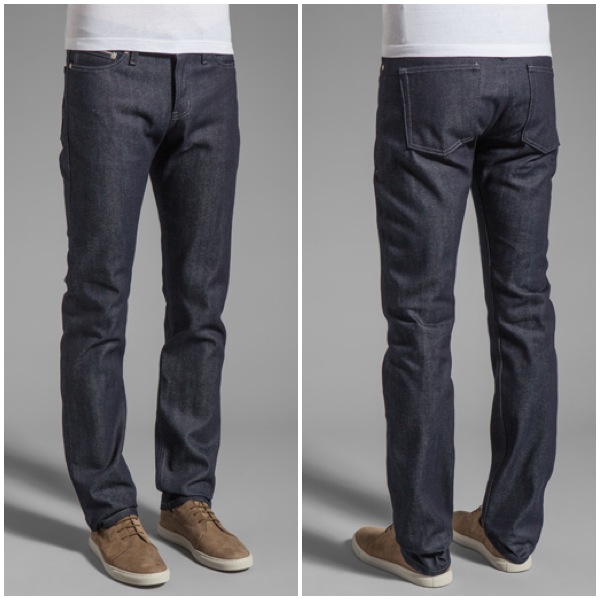
Denim. The first thing that comes to mind after that word should be a pair of jeans. What can you say about this pair of jeans? They’re blue, maybe even black. They probably have two long, hollow tubes in which your legs are supposed to go. They have a fly that you can zip to prevent embarrassment (or forget to zip for maximum embarrassment). That’s about it. You most likely don’t think of the high or low rise, the elastic qualities of the waist, or the tapered leg. Look deeper into the world of denim and you may find yourself surprised at the vast possibilities that these seemingly simplistic pants contain. But have no fear, if you simply want to learn a little more about jeans, theres really only three things you need to know: raw, selvedge and why to buy expensive.

So what makes pricer denim different from the Levi’s that you buy from Kohls? For one, it’s unfinished, or “raw,” qualities. After being dyed, raw denim is not washed, leaving excess dye on the denim that can run off in surprising ways. If you decide to buy a pair of “raws,” you will find that what once was a crisp pair of dark jeans starts to discolor, or “fade,” in some areas, achieving a neat, worn in effect. As opposed to pre-washed jeans, raw jeans can contour and change color according to the movements of your body. The excess jean that bunches up around your knee cap can fade along the crinkles to form a series of faint creases which adds both style and character.

The clothing-savvy may have heard the term “selvedge” used before, but what exactly is selvedge? Is it the same as raw denim? Is it pre-washed denim? Is it just a corporate lie formulated by jean manufacturers to drive up prices? The answer is none of the above. Selvedge actually refers to the practice of weaving together denim strips using a shuttle loom rather than a projectile loom. This produces a crisper border to the fabric, making it sturdier and less likely to unravel. Projectile looms, on the other hand, forgo this crisp border for speed of manufacturing and leave the edge unprotected. Therefore, selvedge denim has a longer lifespan and higher construction quality than cheaper denim at the expense of being more pricey.
With all of this said, I could either go further into the intricacies of this iconic fabric, throwing out terms like “slub,” “sanforized” and “pre-wash” in order to both appear extremely pretentious and completely throw off my audience, or back away and take a look at jeans as a whole. Jeans are not meant as a pair of fancy dress pants, which confuses some when they look at their sometimes sky-high price point ($2000 for a pair of hand-dyed, hand-woven, natural indigo, zimbabwean cotton, silver-buttoned, silk-lined, washed-in-the-Seto-Sea, Momotaro Gold Labels ), but rather as a lifestyle item. Of course, you can accept these words only for so long before you glance at the price tag again and your mouth drops but hear me out. A pair of clothing that you would intend to wear for a lifetime, breaking them in to a point where they start to feel like a second skin with each fade corresponding to a contour in your body, deserves to be just as high a quality as the life you live. A lesser pair of jeans, although adequate, do a less than stellar job of capturing the creases, folds, and dents resulting from a hard day of work. Whether you work the night shift at your local Target or wrangle cattle for a living, jeans, more so than many other pieces of clothing, capture that lifestyle in an unique fashion.




























![Keep the New Gloves: Fighter Safety Is Non-Negotiable [opinion]](https://hilite.org/wp-content/uploads/2024/12/ufcglovescolumncover-1200x471.png)















































![Review: “We Live in Time” leaves you wanting more [MUSE]](https://hilite.org/wp-content/uploads/2024/12/IMG_6358.jpg)
![Review: The premise of "Culinary Class Wars" is refreshingly unique and deserving of more attention [MUSE]](https://hilite.org/wp-content/uploads/2024/12/MUSE-class-wars-cover-2.png)
![Introducing: "The Muses Who Stole Christmas," a collection of reviews for you to follow through winter [MUSE]](https://hilite.org/wp-content/uploads/2024/12/winter-muse-4.gif)
![Review: "Meet Me Next Christmas" is a cheesy and predictable watch, but it was worth every minute [MUSE]](https://hilite.org/wp-content/uploads/2024/11/AAAAQVfRG2gwEuLhXTGm3856HuX2MTNs31Ok7fGgIVCoZbyeugVs1F4DZs-DgP0XadTDrnXHlbQo4DerjRXand9H1JKPM06cENmLl2RsINud2DMqIHzpXFS2n4zOkL3dr5m5i0nIVb3Cu3ataT_W2zGeDAJNd_E-1200x884.jpg)
![Review: "Gilmore Girls", the perfect fall show [MUSE]](https://hilite.org/wp-content/uploads/2024/11/gilmore-girls.png)
![Review in Print: Maripaz Villar brings a delightfully unique style to the world of WEBTOON [MUSE]](https://hilite.org/wp-content/uploads/2023/12/maripazcover-1200x960.jpg)
![Review: “The Sword of Kaigen” is a masterpiece [MUSE]](https://hilite.org/wp-content/uploads/2023/11/Screenshot-2023-11-26-201051.png)
![Review: Gateron Oil Kings, great linear switches, okay price [MUSE]](https://hilite.org/wp-content/uploads/2023/11/Screenshot-2023-11-26-200553.png)
![Review: “A Haunting in Venice” is a significant improvement from other Agatha Christie adaptations [MUSE]](https://hilite.org/wp-content/uploads/2023/11/e7ee2938a6d422669771bce6d8088521.jpg)
![Review: A Thanksgiving story from elementary school, still just as interesting [MUSE]](https://hilite.org/wp-content/uploads/2023/11/Screenshot-2023-11-26-195514-987x1200.png)
![Review: "When I Fly Towards You", cute, uplifting youth drama [MUSE]](https://hilite.org/wp-content/uploads/2023/09/When-I-Fly-Towards-You-Chinese-drama.png)
![Postcards from Muse: Hawaii Travel Diary [MUSE]](https://hilite.org/wp-content/uploads/2023/09/My-project-1-1200x1200.jpg)
![Review: "Ladybug & Cat Noir: The Movie," departure from original show [MUSE]](https://hilite.org/wp-content/uploads/2023/09/Ladybug__Cat_Noir_-_The_Movie_poster.jpg)
![Review in Print: "Hidden Love" is the cute, uplifting drama everyone needs [MUSE]](https://hilite.org/wp-content/uploads/2023/09/hiddenlovecover-e1693597208225-1030x1200.png)
![Review in Print: "Heartstopper" is the heartwarming queer romance we all need [MUSE]](https://hilite.org/wp-content/uploads/2023/08/museheartstoppercover-1200x654.png)




